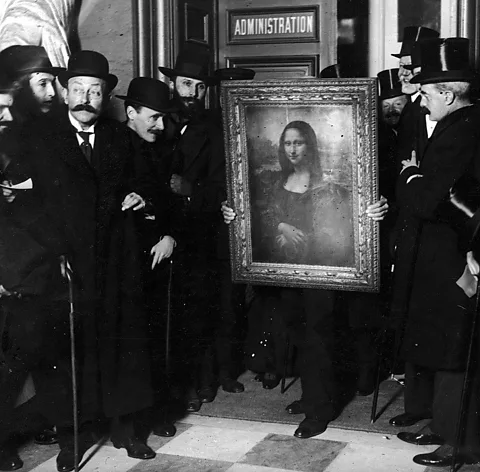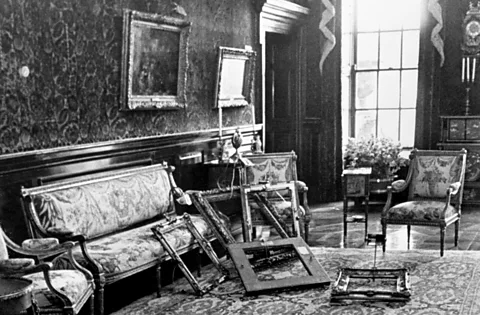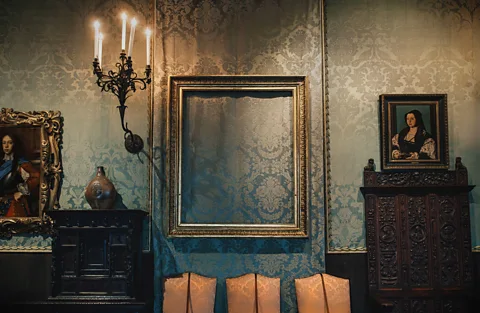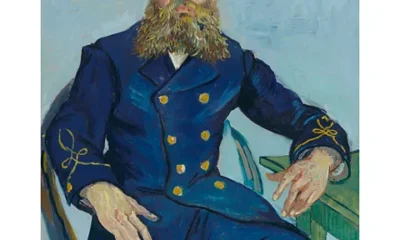Art & Culture
‘Paintings were suddenly seen as money’: The reason art heists exploded in the 1970s

Acclaimed new film The Mastermind, starring Josh O’Connor, tells the story of an art robbery gone wrong. It’s inspired by a wave of similar thefts during a decade known for upheaval.
In May 1972, two men walked into the Worcester Art Museum in Massachusetts and hurried out carrying four paintings by Paul Gauguin, Pablo Picasso and a supposed Rembrandt (now believed to be the work of one of his students), holding a group of visiting high school students at gunpoint and shooting a security guard in the process. With the stolen artworks’ worth tallying up to $2m (£1.5m), the New York Times ranked it among “the largest art robberies in modern times”. Some say it even inspired a far more famous crime nearby: the 1990 heist at Boston’s Isabella Stewart Gardner Museum, in which $500m (£370m) of art was looted, making it the costliest theft in US history full stop, with the crime remaining unsolved.
The Worcester heist was orchestrated by career criminal Florian “Al” Monday, but the game was up after the two thieves he hired for the raid boasted about their exploits in their local bar. Within a month, the paintings were safely retrieved from a pig farm in Rhode Island and returned to the gallery. “Ironically, Monday – before he was an art thief – had a band, and I have the 45 of his record,” writer-director Kelly Reichardt tells the BBC. Her new film The Mastermind, which is released in the US this weekend, is loosely inspired by the chain of events that followed the Worcester robbery, as well as the wave of art heists that followed over the course of that decade.

Praised by The Guardian’s film critic Peter Bradshaw for locating “the unglamour in the heist”, Reichardt’s thoughtful art crime caper dismantles the usual rules of the glitzy, sensationalised heist movie. Blockbusters have long popularised the idea that there is something classy about this category of crime, particularly when it involves art: think, for example, of the 1999 version of The Thomas Crown Affair, in which Pierce Brosnan plays a very suave billionaire orchestrating a raid on New York’s Metropolitan Museum of Art.
Reichardt’s take on the genre adopts a slower pace and more exacting eye for the way in which its art robbery cataclysmically unfolds. Josh O’Connor takes the title role as the brains behind the operation: JB Mooney, a middle-class, well-educated art school drop-out now ailing as an underemployed carpenter in Massachusetts. Under pressure from his well-to-do parents – a retired judge (Bill Camp) and a socialite (Hope Davis) – to repay their loans to him, he cases the fictional Framingham Art Museum for a heist. But from the moment that one of his henchmen asks how he plans to sell on the stolen paintings – which would be difficult due to their recognisability – the scheme begins to go awry.
If you start to get down into the minutiae of a robbery like this and don’t concentrate on the bigger strokes, then by nature it becomes de-glamorised – Kelly Reichardt
Reichardt came across an article about the 50-year anniversary of the Worcester Art Museum robbery while working on her previous film, Showing Up (2002), a comedy drama about two rival sculptors, and decided to use the story as the foundation of her next feature. All that was left to do was to create the character of JB. “The political ideas, the genre ideas – these are things you think about and study, but then you have to let go of all that and concentrate on the details of the film you’re making with what your character situation is like,” says Reichardt. “If you start to get down into the minutiae of those things and don’t concentrate on the bigger strokes, then by nature it [becomes] de-glamorised.”
Reading about the 1972 robbery brought back memories for Reichardt of the “many smash-and-grabs at the time” that frequently appeared in newspaper headlines. Mere months after the Worcester Art Museum heist, a robbery since dubbed the “skylight caper” took place in Canada – the Montreal Museum of Fine Arts was raided by three armed robbers, who clinched $2m (£1.5m) of paintings, jewels and valuable objects, marking the largest theft in the nation’s history. Across the Atlantic, in 1976, 119 of Picasso’s final works were pilfered from France’s Palais des Papes by three thieves while they were on show during a visiting exhibition.

Then there was the case of Rose Dugdale, an Oxford University graduate and heiress turned fierce Irish republican, who was the focus of Joe Lawlor and Christine Molloy’s high-octane 2023 art-heist drama Baltimore. In 1974, together with several IRA members, she took 19 paintings by the likes of Johannes Vermeer and Peter Paul Rubens from Ireland’s Russborough House, and held them to ransom, hoping for the release of imprisoned IRA members. Lawlor told Cineuropa: “There was something incredibly well organised about it and really badly thought out. They are so driven but completely blind to the wider political reality.”
The history of art theft
Before this spate of burglaries, history had seen countless other lootings and plunderings of prized art pieces, from the 1473 theft by pirates of Hans Memling’s The Last Judgment from a ship bound for Florence, to the infamous purloining of the Mona Lisa from the Louvre in 1911 by Vincenzo Peruggia, an embittered former employee at the gallery. When he was caught two years later, he only served a six-month prison sentence.
Yet the Massachusetts robbery undeniably signalled a gear change for the art heist industry. According to art historian Tom Flynn, the surge in heists in the 1970s “coincides with the boom of the art market”. Citing the 1977 launch of Antiques Roadshow – the long-running BBC TV show in which a team of experts appraise art pieces and objects – and its ensuing popularity, Flynn adds: “It’s a cultural change where we start to see works of art as the equivalent of money.”
Meanwhile, criminals were becoming aware of the flimsiness of museum security, making works of art seem an easy target. News reports in the early 1970s warned of funding “crises” for museums and cutbacks in security, particularly amid high inflation. Smaller-scale thefts, such as the stealing of Francisco Goya’s portrait of the Duke of Wellington from London’s National Gallery in 1961 and the disappearance of three Rembrandts from Dulwich Picture Gallery in 1966, revealed how straightforward it could be simply to lift a painting from gallery walls undetected.
Part of the appeal of these characters is their outsmarting the establishment. The fact that art heists usually don’t involve private individuals makes it more acceptable – Susan Ronald
Like the guard injured during the Worcester Art Museum robbery, security employees rarely carried arms – and, as portrayed mockingly in The Mastermind, they could often be dozy “retirees” or “acid heads”, as Reichardt says, with limited training. She adds: “Museums used to have these cool circular drives out front, which made the getaway pretty handy.” And, while the film features an FBI art crime investigator reminiscent of real-life agent Robert Wittman – who recovered $300m (£225m) worth of art over the course of his career – the actual FBI Art Crime Team was only founded in 2004.

But as Flynn notes, while museums may have been slow to appreciate the threat of robbery in the past, the robbers have not generally displayed the sharpest acumen either. “The history of art crime and major art heists has been one of opportunist idiots who don’t really understand the nature of works of art themselves,” he says, referring to their potential for damage, “or indeed the market for works of art. [Then] these guys suddenly discover, to their horror, that the objects they’ve stolen are very difficult things to shift.”
The allure of the art robber
An archetype in fiction of the art robber as lovable rogue also started to emerge during the 1960s and ’70s. Amid unrest driven by the Vietnam War and the Nixon administration, disillusionment and discontent reached high levels, especially among younger generations in the US. Simultaneously, films such as 1964’s Topkapi (where a band of art thieves attempt to steal from a palace in Istanbul), 1966’s How to Steal a Million (where Audrey Hepburn and Peter O’Toole plan a heist to altruistic ends) and the same year’s Gambit (starring Michael Caine as a plucky cat burglar stealing an antique bust) helped to glamorise such characters.
According to historical author Susan Ronald, who specialises in art crime, the rise of the art robber in pop culture reflects the time’s anti-authority mentality. “Part of [the appeal of these characters] is [their] outsmarting the establishment,” she explains. “The fact that art heists usually don’t involve private individuals makes it more acceptable. It’s an institution, and there’s something quite daring about it.”
Perhaps it’s partly down to the glorification of these art stealers that misconceptions about arts heists have taken root – for example, the idea of them being a “victimless crime”. “We don’t take it seriously enough,” says Flynn, “which is why the criminals quite often get ridiculous [short] sentences when you consider that they’ve committed a serious cultural crime. But because it’s art, we don’t think it’s so important.”

The Mastermind works in many ways to upend entrenched ideas about art robbers. From Caine in Gambit to Alain Delon in Jean-Pierre Melville’s Le Cercle Rouge (1970), such a figure was often represented as a heartthrob in the films of that time. But, with JB, Reichardt hoped to subvert that. “These guys are [actually] such jerks. They’re misogynist. They can afford to break away and do what they want. They’re not pinned down with kids. Just the idea of being able to be the outlaw is a privilege, but in the end you root for them, it’s just a narrative thing.”
More like this:
• Meet the world’s greatest art detective
• 12 of the best films to watch this October
• Why 1971 was an extraordinary film year
We get a nuanced perspective on JB’s character through his long-suffering wife, Terri (Alana Haim), and unimpressed fellow graduate Maude (Gaby Hoffman), both forced to put up with his antics. “There is an added, more objective look at him at times through the women in JB’s life who he counts on, who are taxed by his freedom. Personal freedom being a huge theme in American politics today – but at what cost and who carries the weight of that?”
Today, robberies of public museums and galleries are far less frequent, with criminals now “cottoned on to the fact that these are essentially non-fungible objects”, says Flynn. However, recent funding cuts by the US government could spell a troubling future for museum security again – even if there are bigger threats to paintings these days, says heritage consultant Vernon Rapley. “It’s not just security that will suffer – it will be the very fabric of the buildings as well. If you don’t invest in your roofs and windows, then ultimately, weather and climate change are probably a greater risk to objects, in fact, than criminals are.”
The Mastermind is released in US cinemas on 17 October and UK cinemas on 24 October
Art & Culture
From Bank Lines to Bus Seats: Bold Lessons in Courtesy, Courage, and Everyday Survival

In the line of bill payers at the bank,
As the fairer sex,
If sick, don’t just be blank
“Ladies first”, “excuse me11, “before you please.”
For deals with unpaid bills,
Ask for goods back, threat if you will,
Repeat the request for a job.
You may make it from the mob,
Instead of standing, share the seat on the bus
Isn’t it much better than making a fuss,
Whatever you do during tug-of-war, do not push the rope
Or you’ll be the laughing stock amidst cries of, “What a dope.”
Art & Culture
Bareendo of Pakistan Inscribed on UNESCO’s Intangible Cultural Heritage (ICH) List

Paris(Imran Y. CHOUDHRY):- Bareendo (Bhorindo), one of the oldest surviving folk instruments of Sindh, has been officially inscribed on UNESCO’s list of Intangible Cultural Heritage (ICH) in need of urgent safeguarding. The decision was adopted at the 20th Session of the Intergovernmental Committee for the Safeguarding of the Intangible Cultural Heritage.

The Bareendo is a clay wind instrument whose origins trace back to the 5,000-year-old Indus Valley Civilization. It is a symbol of Sindh’s spiritual and communal traditions. For centuries, its soft and meditative tones have accompanied winter gatherings, Sufi practices, and rural celebrations. Today, however, the tradition is endangered, with only one master musician, Ustaad Faqeer Zulfiqar, and one master potter, Allah Jurio, preserving its complete knowledge.
The nomination of Bareendo as an ICH in urgent need of safeguarding is the result of an intensive consultative process between the Government of Sindh, Pakistan Mission’s to UNESCO in France and the UNESCO Headquarters. It was inspired by a community-led and participatory process in the village of Keti Mir Muhammad Loond village in Sindh province to protecting Bareendo as a cultural heritage. Their efforts shaped the comprehensive Four-Year Safeguarding Plan (2026–2029), which includes the establishment of a community music school, integration of Bareendo heritage into formal and informal education, and the use of digital platforms to expand cultural outreach. UNESCO’s inscription will support the conservation process.
Permanent Delegate of Pakistan to UNESCO Ambassador Mumtaz Zahra Baloch welcomed the decision of UNESCO’s Intergovernmental Committee to inscribe Bareendo as an Intangible Cultural Heritage in urgent need of safeguarding. “The inscription of Bareendo is a proud moment for Pakistan and a tribute to the communities who have preserved this ancient instrument and music for generations. Bareendo is not only an emblem of the Indus Valley’s cultural continuity but also a living expression of Sindh’s artistic and spiritual heritage.”
“This recognition by UNESCO reaffirms Pakistan’s commitment to the protection and promotion of our diverse cultural traditions. We look forward to working closely with UNESCO to ensure that the knowledge, craftsmanship, and musical identity of the Bareendo is transmitted to future generations”, she said.
Art & Culture
“The Backyard Ballet: Cat and Crow in Comic Courtship — A Poem by Zeenat Iqbal Hakimjee”

My backyard is livened up
By the cat and the crow.
From a distance they for each other
A liking show.
Caw Caw, Meow Meow they hark & howl.
A din enough, to disturb the neighbouring fowl
Both of them perched on the dustbin.
Turn by turn.
Waiting for a morsel, from the kitchen to return.
Up goes the left over meat, in the air,
What ensues would ashame ‘The battle for the chair
-

 Europe News10 months ago
Europe News10 months agoChaos and unproven theories surround Tates’ release from Romania
-

 American News10 months ago
American News10 months agoTrump Expels Zelensky from the White House
-

 American News10 months ago
American News10 months agoTrump expands exemptions from Canada and Mexico tariffs
-

 American News10 months ago
American News10 months agoZelensky bruised but upbeat after diplomatic whirlwind
-

 Art & Culture10 months ago
Art & Culture10 months agoThe Indian film showing the bride’s ‘humiliation’ in arranged marriage
-

 Art & Culture10 months ago
Art & Culture10 months agoInternational Agriculture Exhibition held in Paris
-

 Pakistan News6 months ago
Pakistan News6 months agoComprehensive Analysis Report-The Faranian National Conference on Maritime Affairs-By Kashif Firaz Ahmed
-

 Politics10 months ago
Politics10 months agoUS cuts send South Africa’s HIV treatment ‘off a cliff’




















